New Era, New Curriculum
Air Date: Week of November 19, 2010
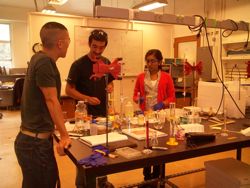 |
Many Americans are re-evaluating their relationship with chemicals, asking where they end up in people and the environment once they've fulfilled their intended use. Now universities are teaching students to ask those same questions. Ingrid Lobet reports on changes at UC Berkeley.
Transcript
GELLERMAN: For more than 60 years the chemical company DuPont promised, “Better things for better living through chemistry”. Well, these days the slogan might say: “better chemistry for better living.”
In laboratories across the country chemists are trying to come up with new formulas to make safer products. And students at many universities are learning how to do it. It’s called green chemistry. Living On Earth’s Ingrid Lobet reports on the changes at one of the nation’s most influential chemistry departments: the University of California, Berkeley.
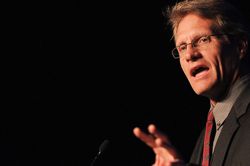
Environmental Health Researcher Dr. Michael Wilson (UC Berkeley)
[SOUNDS OF AN AUTO REPAIR SHOP, TORQUE WRENCH]
LOBET: Two blocks from the UC Berkeley campus, Michael Wilson stands outside a garage.
WILSON: So, we’re at a very typical automotive repair shop. We have about six or eight mechanics working here with vehicles on hydraulic jacks and as you can see this is a fairly solvent-intensive process.
LOBET: Wilson is a professor of public health now, but eight years ago he was a fire fighter-paramedic, studying for his PhD here in environmental health, when he heard about the case of an injured worker.
WILSON: A young man, a 24-year old automotive mechanic, with really advanced symptoms of neurological disease. He had lost his sensory and motor function in his limbs. He had at lost his grip strength; he was in a wheelchair.
LOBET: The state health department had a hunch about what was happening to this young man.
WILSON: He was going through about eight to ten cans a days of a commercially available, break-cleaning solvent product that was formulated with hexane and acetone. And that formulation causes nerve damage.
LOBET: Wilson wondered whether this was an isolated case, so he started visiting other auto repair shops. He found 14 more mechanics with similar neurological damage just in the Bay Area. They would spray the cleaning solvent on cars, then work while the vapor evaporated, as Wilson put it, in their breathing zone.
[SOUNDS OF TOOLS DROPPING]
LOBET: This toxic brake cleaner wasn’t something that had been around for years and somehow escaped the attention of California regulators. It was a new product. California officials had asked manufacturers to remove some of the hexane from their cleaner because it can turn into ozone, which burns people’s lungs and aggravates asthma. They did. And replaced it with acetone.
WILSON: Why is it that a known neurotoxic solvent was used under completely uncontrolled conditions by workers across the state of California?
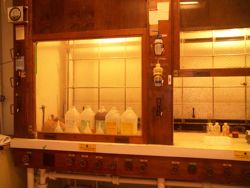
A typical fume hood. Some departments are remodeling their labs with fewer of these hoods. (Photo: Ingrid Lobet)
[SOUND OF THE BERKLEY BELL TOWER]
LOBET: On campus, Mike Wilson says, he found himself in the precarious position of wanting to change a profession he was just entering.
WILSON: Our field has typically been about measuring the extent of the damage, and I became interested in the next level of question which was: Why are we creating these occupational and environmental health hazards in the first place? Don’t we have the have the talent and the resources to create safer chemicals and safer products from the beginning?
LOBET: These questions led Wilson to the field of green chemistry. Established by Paul Anastas and John Warner in the 1990s, it’s the emerging field that looks at where chemicals end up in people and the environment, and advocates safer substances. Next, Wilson began talking with the university chemistry department.
WILSON: What we found here at the Berkeley campus was that chemistry education hadn’t really changed much in the last 30-40 years.
LOBET: Not too long after, Wilson met a new chemistry grad student who’d arrived at the university. Marty Mulvihill and Mike Wilson had something in common—call it a public interest approach.
MULVIHILL: While I was here, it was really important to me not only that I do research, but that I reach out to my community and think about the ways that chemists specifically could influence society. Like, we use a lot of resources from society—chemistry is a very resource intensive thing—like, how do we give back?
LOBET: With this kind of community orientation it was natural that the first thing Mulvihill did when he got to Berkeley was start organizing other chemistry grad students.
MULVIHILL: The name of that group was actually Chemists for Peace, which turned out to be far too controversial for a place like Berkeley. I mean, there’s like that perception that Berkeley is an activist-oriented thing, but when you look at chemistry, anything that even appears political is not widely accepted.
So, we produced a lot of coffee mugs, people generally liked that we were around, but it never really took hold.

Dr. Marty Mulvihill stands at a traditional hood. Some school are trying to reduce the need for vapor hoods by using more benign substances. (Photo: Ingrid Lobet)
LOBET: It dawned on Mulvihill that he needed to be speaking science to scientists. So he and a core of other grad students organized their own seminar series.
They got a grant from the Dow chemical company, and brought in top thinkers in green chemistry: John Warner, Paul Anastas, Terry Collins. At first Mulvihill says, the Chemistry department wouldn’t even give them a room to meet in, but gradually the students prevailed.
MULVIHILL: I can remember the evening it happened. The dean had just come in. I think it was his first, maybe his second year. The graduate seminar was going on and John Warner, one of the fathers, one of the guys who wrote the original book on green chemistry, had agreed to come to campus and give a talk. And the Dean actually showed up to that talk. Not only show up for the talk, but he came out to dinner afterwards, and it was so fun to watch as the Dean and John Warner, so it’s Dean Rich Mathies and John Warner interacted and all of a sudden I realized, now it is bigger than me.
LOBET: To really appreciate the significance of what’s happening at Berkeley and other campuses around the country, you have to understand just how remote health concerns have been for most chemists. This area of science is toxicology: the study of the adverse affects of chemical, and also physical and biological agents on living things.
MULVIHILL: A traditional chemistry training doesn’t teach you a lot about the fate of things. You learn a lot about how to make it, and how to make it cheaply and efficiently- that’s all part of the traditional science training. Where they end up, what their possible effects are on human health and the environment, that just traditionally hasn’t been part of a chemistry education.
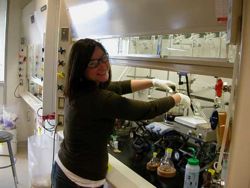
Alison Narayan is a fifth year organic chemist and organizer of the student-led green chemistry seminar at Berkeley (Photo: UC Berkeley)
NARAYAN: We’re working with these chemicals all the time but we don’t necessarily know how toxic they are. Or if they are toxic, like what their mode of action is, or why they are harmful to you.
LOBET: That’s Alison Narayan, another organizer of the student-run seminar series. Narayan is a fifth year organic chemist, making entirely new compounds.
NARAYAN: Really how we are trained is to focus on the reactivity of the chemicals and developing new reactions and new ways to build things, not necessarily even evaluating the performance of those materials or the toxicity of those materials.
LOBET: Narayan says she’s been surprised by the lack of toxicology training in her chemistry education. And environmental health scientist Michael Wilson says it seemed strange to him too.
WILSON: The fact is that in the United States you can earn a bachelor’s degree and a master’s degree and a PhD in chemistry at the universities and colleges across the United States and never demonstrate a basic understanding of how chemicals affect human health or the environment. And, so, are we surprised than toxic materials are finding their way into consumer products that are widely available on the market? We probably shouldn’t be.
LOBET: And Wilson says chemists aren’t the only scientists who have not paid much attention to toxicology. Amazingly, even public health experts often aren’t trained in it.
WILSON: So we are seeing a transformation in the school of public health embracing this idea of green chemistry, where, up to now, our job has really been about identifying, measuring characterizing the extent of the problem. It’s simply no longer possible for us in public and environmental health to clean the mess up at the end of the pipe. We have to design chemicals, we have to design products in ways they don’t show up in human blood, and in breast milk, and in hazardous waste sites, and in groundwater.
LOBET: The first big signs of changes taking place at Berkeley, besides the student-organized seminar, happened last summer. For the first time, the university offered its entry-level chemistry course with the option of a single lab section that was green.
[SOUND OF STUDENTS WORKING ON LAB BENCH]
LOBET: On this day, second-year students Swetha Akella and Michael Poon are doing a practice run through one of the new labs.

Second year students Michael Poon, Max Babicz and Swetha Akella help refine one of the new green lab experiments. (Photo: Ingrid Lobet)
POON: What she’s actually trying to do find the concentration of the dyes in the drinks to see how much we are consuming. Red 40 is very common in a lot of consumables. Because the amount of dye is very small, to get a measurable amount you have to boil off the water, and that increases the percentage of dyes in the sample. This is Sunkist and Hawaiian Punch.
AKELLA: I think the thing that really appeals to me is the practicality, because a lot of times you do a lab where you find, like, a concentration and you just like, forget about it afterwards. But when you do like, the sunscreen lab, or this lab, you really think about it the next time you put on sunscreen or the next time you decide to drink a soda.
LOBET: Poon points out, it’s not just a question of lab subject matter.
POON: I think it is a really important to think about where your actions are leading. If you pour something down a drain, where does it go? Think about that, and what needs to be done to process that to clean it up, to make it so that that water is usable again.
LOBET: A review of class evaluations from students who took that first green chemistry lab in the summer shows a lot of enthusiasm. Chantelle Khambholja was won of those freshmen.
KHAMBHOLJA: Well, our first lab section was on biofuels. And, in the first lab we went through and looked at the effects of biofuel on germination of seeds to measure ecotoxicity. In the second lab, we actually synthesized our own biodiesel, which was awesome, and in the third lab, we measured the amount of energy produced when it was burned.
LOBET: This fall term, the Berkeley Chemistry department converted all of the introductory lab sections into green chemistry labs. Berkeley chemistry lecturer Michelle Douskey oversees teaching assistants for the introductory classes. She says traditional chemistry curricula have been too focused on memorization. She’s trying to change that. The overlay of green chemistry, she says, will make content even more relevant for students who are already asking these questions.
DOUSKEY: The students are really curious about personal care products. What is in their water bottle? Is there lead in the paint in my really old apartment? And, all of these are chemistry problems.
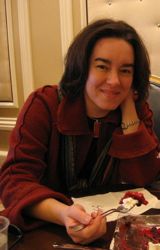
Dr. Michelle Douskey lectures in chemistry at Berkeley. (Photo: Scott Olson)
LOBET: A typical curriculum or text, Douskey says, might devote one problem to someone concerned about lead in drinking water, then move on to the next problem.
DOUSKEY: Maybe if we look at lead in paint, we might look at it from many different angles. We might revisit it throughout the semester. Is it going to stay in the paint or not? If it get’s in the dust then where does it go? Then there’s all of that chemistry stuff like how do I even detect for lead in paint? So that’s how we wrap in things like, well, light interacts with matter and we have certain instruments that help us to put some numbers on these things. So, I kind of feel like the green chemistry perspective is going to allow us to tell a more complete story. It was like we were telling part of a story before, you know, ‘oh well, you don’t need to know where this came from.’
LOBET: That idea, of teaching the whole story, has been central at the University of Oregon for more than a decade. As a leader in green chemistry, it’s taught two hundred chemistry faculty from around the country in annual week-long workshops. That gives U of O assistant department head Julie Haack a clear view of the changes at Berkeley.
HAACK: I think the changes that are happening at Berkeley are an incredible validation of this approach.
LOBET: A validation because of Berkeley’s heft and reach. Each year, 24 hundred incoming students will be learning their most basic chemistry principles …green.
HAACK: I think the impact is huge. These are the future decision makers in our society and what we’ve seen, once the students are armed with the tools of green chemistry, they really become empowered to participate in the solutions of finding more sustainable products and processes.
LOBET: If chemist Alison Narayan is any indication, the changes will be broad, from the mundane to the profound.
NARAYAN: So it does make me think about the way I do chemistry, for example reducing the amount of waste you have. We actually had a discussion last night in our research group meeting about reusing test tubes. So, we use lots of test tubes and then usually when we’re done with these, we just throw them away. So in my spare time when I am in my hood working up reactions, or on the bus on my way to lab, I find myself thinking about what else could you make that from? Instead of using this commodity chemical from petroleum, what else could you make that from? So it does, it does color the way I think about things and the type of daydreaming that I do.
LOBET: Berkeley has now opened a center for green chemistry. It’s planning a new graduate course in the spring. And it will be offer a new green chemistry emphasis that students may choose and that shows up like a minor on their transcripts. All these changes have not escaped the notice of the chemical industry, says Mike Wilson.
WILSON: These are discussions that strike at the very heart of the chemical enterprise, the things that we are writing about and the things that we are teaching have enormous influence for some of the largest industry groups and the largest companies in the world. And they certainly have an interest in influencing what we do here, and so we have had to be very careful, because we certainly want these companies to embrace the idea of green chemistry, not as a green wash, as a fundamental element of their corporate mission. But we also have to be independent in the way that we conduct our work, so there is an inherent tension there that we work with almost every day.
LOBET: That tension may be stronger at Berkeley, where the changes in chemistry teaching have implications for chemical policy across California. But the shift to green chemistry at universities around the country seems clear. Again, Julie Haack of the University of Oregon.
HAACK: Our goal is that green chemistry will just become the way chemistry is taught. And, pretty soon green chemistry will disappear and it will just become the way chemistry is done.
LOBET: At Berkeley professors say the goal is to turn out the next generation of not just chemists, but writers, politicians, and attorneys who can understand the consequences of the way things are made. For Living On Earth, I’m Ingrid Lobet.
Links
Green Chemistry Education Network at U of O
Database of curriculum material for educators GEMS -- Greener Education Materials
Warner Babcock Institute for Green Chemistry
U Mass Center for Green Chemistry
Yale Center for Green Chemistry
Berkeley Center for Green Chemistry
Living on Earth wants to hear from you!
Living on Earth
62 Calef Highway, Suite 212
Lee, NH 03861
Telephone: 617-287-4121
E-mail: comments@loe.org
Newsletter [Click here]
Donate to Living on Earth!
Living on Earth is an independent media program and relies entirely on contributions from listeners and institutions supporting public service. Please donate now to preserve an independent environmental voice.
NewsletterLiving on Earth offers a weekly delivery of the show's rundown to your mailbox. Sign up for our newsletter today!
 Sailors For The Sea: Be the change you want to sea.
Sailors For The Sea: Be the change you want to sea.
 The Grantham Foundation for the Protection of the Environment: Committed to protecting and improving the health of the global environment.
The Grantham Foundation for the Protection of the Environment: Committed to protecting and improving the health of the global environment.
 Contribute to Living on Earth and receive, as our gift to you, an archival print of one of Mark Seth Lender's extraordinary wildlife photographs. Follow the link to see Mark's current collection of photographs.
Contribute to Living on Earth and receive, as our gift to you, an archival print of one of Mark Seth Lender's extraordinary wildlife photographs. Follow the link to see Mark's current collection of photographs.
 Buy a signed copy of Mark Seth Lender's book Smeagull the Seagull & support Living on Earth
Buy a signed copy of Mark Seth Lender's book Smeagull the Seagull & support Living on Earth

